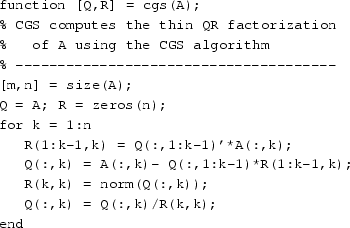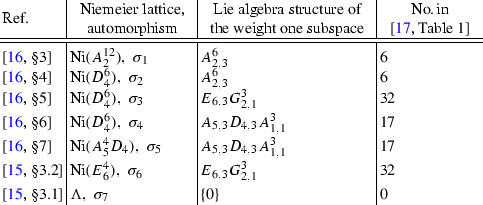Suppose we shuffle a deck of cards; what is the probability that nocard is in its original location? More generally, how manypermutations of $[n]={1,2,3,ldots,n}$ have none of the integers in their'correct' locations? That is, 1 is not first, 2 is not second, andso on. Such a permutation is called a derangement of $[n]$.
Let $S$ be the set of all permutations of $[n]$ and$A_i$ be the permutations of $[n]$ in which $i$ is in the correctplace. Then we want to know $ bigcap_{i=1}^n A_i^c $.
‖ X ‖ 2 = 40.2 ‖ 1 m T ‖ 2 = 32 ‖ X treatment ‖ 2 = 8 ‖ X individual ‖ 2 = 0.2 A classical F -test looks at the ratio of the last two numbers, taking into account the appropriate numbers of degree of freedom, one for the treatment effect and six for the within variation. Of current CPU-centric systems by 1:2 2:8. While the performance improvement offered by our Tensor Casting algorithm is impressive, we observe that the baseline CPU-centric system does not fully reap out the potential of our proposal. To maximally utilize the opportunities inherent with our algorithm-architecture co-design, the second key.
For any $i$, $ A_i =(n-1)!$: once $i$ is fixed in position $i$, theremaining $n-1$ integers can be placed in any locations.
What about $ A_icap A_j $? If both $i$ and $j$ are in the correctposition, the remaining $n-2$ integers can be placed anywhere, so$ A_icap A_j =(n-2)!$.

In the same way, we see that $ A_{i_1}cap A_{i_2}capcdotscap A_{i_k} =(n-k)!$. Thus, by theinclusion-exclusion formula, in the form of equation 2.1.1, $$eqalign{ bigcap_{i=1}^n A_i^c &= S +sum_{k=1}^n (-1)^k{nchoose k}(n-k)!cr&=n!+sum_{k=1}^n (-1)^k{n!over k!(n-k)!}(n-k)!cr&=n!+sum_{k=1}^n (-1)^k{n!over k!}cr&=n!+n!sum_{k=1}^n (-1)^k{1over k!}cr&=n!,Bigl(1+sum_{k=1}^n (-1)^k{1over k!}Bigr)cr&=n!,sum_{k=0}^n (-1)^k{1over k!}.cr}$$The last sum should look familiar:$$e^x=sum_{k=0}^infty {1over k!}x^k.$$Substituting $x=-1$ gives$$e^{-1} = sum_{k=0}^infty {1over k!}(-1)^k.$$The probability of getting a derangement by chance is then$${1over n!}n!,sum_{k=0}^n (-1)^k{1over k!}=sum_{k=0}^n (-1)^k{1over k!},$$and when $n$ is bigger than 6, this is quite close to $$e^{-1} approx 0.3679.$$So in the case of a deck of cards, the probability of a derangement isabout 37%.
Let $D_n=n!,sum_{k=0}^n (-1)^k{1over k!}$.These derangement numbers have some interesting properties. First, note that when$n=0$, we have $D_0=0!(-1)^0{1over 0!}=1$. 'Derangements of theempty set' doesn't really make sense, but it is useful to adopt theconvention that $D_0=1$.

The derangements of $[n]$ may be produced as follows: For each$iin{2,3,ldots,n}$, put $i$ in position 1 and 1 in position $i$. Then permute the numbers ${2,3,ldots,i-1,i+1,ldots n}$ in all possible ways so that none of these $n-2$ numbers is in the correct place. There are $D_{n-2}$ ways to do this. Then, keeping 1 in position $i$, derange the numbers ${i,2,3,ldots,i-1,i+1,ldots n}$, with the 'correct' position of $i$ now considered to be position 1. There are $D_{n-1}$ ways to do this. Thus, $D_n=(n-1)(D_{n-1}+D_{n-2})$. Starting with $D_0=1$ and $D_1=0$, this gives $D_2=(1)(0+1)=1$ and$D_3=(2)(1+0)=2$, both of which are easy to check directly.
We explore this recurrence relationa bit:$$eqalignno{D_n&=nD_{n-1}-D_{n-1}+(n-1)D_{n-2}&(*)cr&=nD_{n-1}-(n-2)(D_{n-2}+D_{n-3})+(n-1)D_{n-2}cr&=nD_{n-1}-(n-2)D_{n-2}-(n-2)D_{n-3}+(n-1)D_{n-2}cr&=nD_{n-1}+D_{n-2}-(n-2)D_{n-3}&(*)cr&=nD_{n-1}+(n-3)(D_{n-3}+D_{n-4})-(n-2)D_{n-3}cr&=nD_{n-1}+(n-3)D_{n-3}+(n-3)D_{n-4}-(n-2)D_{n-3}cr&=nD_{n-1}-D_{n-3}+(n-3)D_{n-4}&(*)cr&=nD_{n-1}-(n-4)(D_{n-4}+D_{n-5})+(n-3)D_{n-4}cr&=nD_{n-1}-(n-4)D_{n-4}-(n-4)D_{n-5}+(n-3)D_{n-4}cr&=nD_{n-1}+D_{n-4}-(n-4)D_{n-5}.&(*)cr}$$It appears from the starred lines that the pattern here is that $$D_n=nD_{n-1}+(-1)^kD_{n-k}+(-1)^{k+1}(n-k)D_{n-k-1}.$$If this continues, we should get to$$D_n=nD_{n-1}+(-1)^{n-2}D_{2}+(-1)^{n-1}(2)D_{1}.$$Since $D_2=1$ and $D_1=0$, this would give$$D_n=nD_{n-1}+(-1)^n,$$since $ds (-1)^n=(-1)^{n-2}$. Indeed this is true, and can be provedby induction. This gives a somewhat simpler recurrence relation,making it quite easy to compute $D_n$.
Permute 2 2.2.8 Torrent
$$bulletquadbulletquadbullet$$There are many similar problems.
Example 2.2.1 How many permutations of$[n]$ contain no instance of $i$ followed by $i+1$?
By a similar useof the inclusion-exclusion formula, it turns out that this is $$Q_n=n!,sum_{k=0}^{n-1} (-1)^k{1over k!}+(n-1)!,sum_{k=1}^{n-1} (-1)^{k-1} {1over (k-1)!}.$$Note that the limits on the two sums are not identical.
Exercises 2.2

Ex 2.2.1Prove that $ds D_n=nD_{n-1}+(-1)^n$ when $nge2$, byinduction on $n$.
Ex 2.2.2Prove that $D_n$ is even if and only if $n$ is odd.
Ex 2.2.3Provide the missing details forexample 2.2.1.What is $dslim_{ntoinfty} {Q_nover n!}$?
Ex 2.2.4Find the number of permutations of $1,2,ldots,8$ that have noodd number in the correct position.
Ex 2.2.5Find the number of permutations of $1,2,ldots,8$ that have at least oneodd number in the correct position. Luxonix purity serial number.
Ex 2.2.6How many permutations of $[n]$ have exactly $k$ numbers intheir correct positions?
Ex 2.2.7Give a combinatorial proof that$$n!=sum_{k=0}^n {nchoose k}D_{n-k}.$$


Ex 2.2.8A small merry-go-round has 8 seats occupied by 8children. In how many ways can the children change places so that nochild sits behind the same child as on the first ride? The seats donot matter, only the relative positions of the children.
Ex 2.2.9Repeat the previous problem with $n$ instead of $8$.
Ex 2.2.10On the way into a party everyone checks a coat and a bag at the door. On the way out, the attendant hands out coats and bags randomly. In how many ways can this be done if
(a) No one gets either their own coat or their own bag?
(b) One may get one's own coat, or bag, but not both.
Ex 2.2.11Suppose $n$ people are seated in $mge n$ chairs in aroom. At some point there is a break, and everyone leaves theroom. When they return, in how many ways can they be seated so that noperson occupies the same chair as before the break?
Download Wirecast Pro 14.0.1 for macOS full version program setup free. Wirecast Pro is a powerful and versatile live streaming production application that provides the required tools to capture video, encode it and broadcast it to multiple servers and platforms at the same time. Wirecast Pro 14.0.1 for macOS Review Wirecast Pro 14 is an industry standard when it comes to live streaming production. This fantastic live streaming production application provides the required tools to capture video, encode it and …